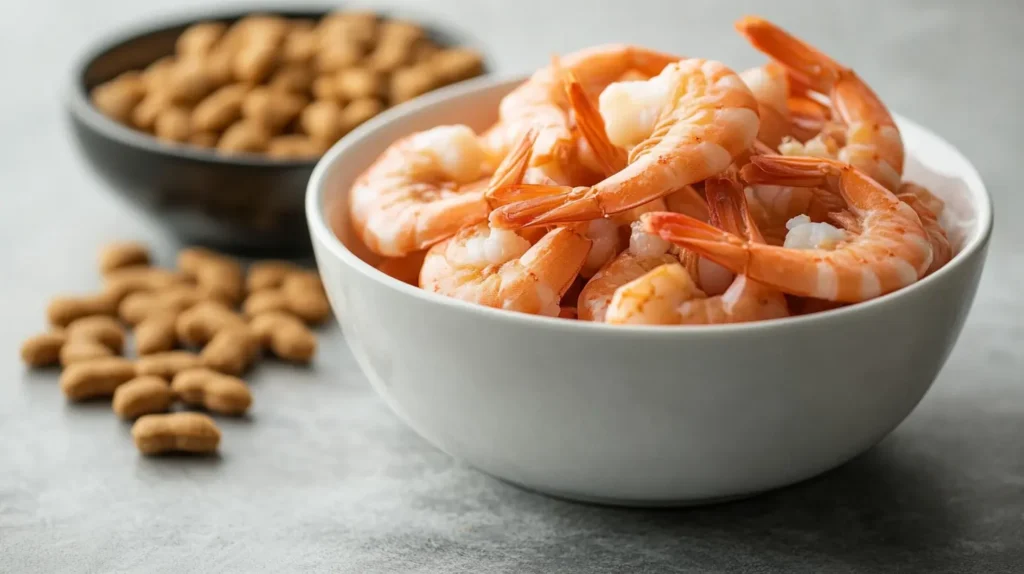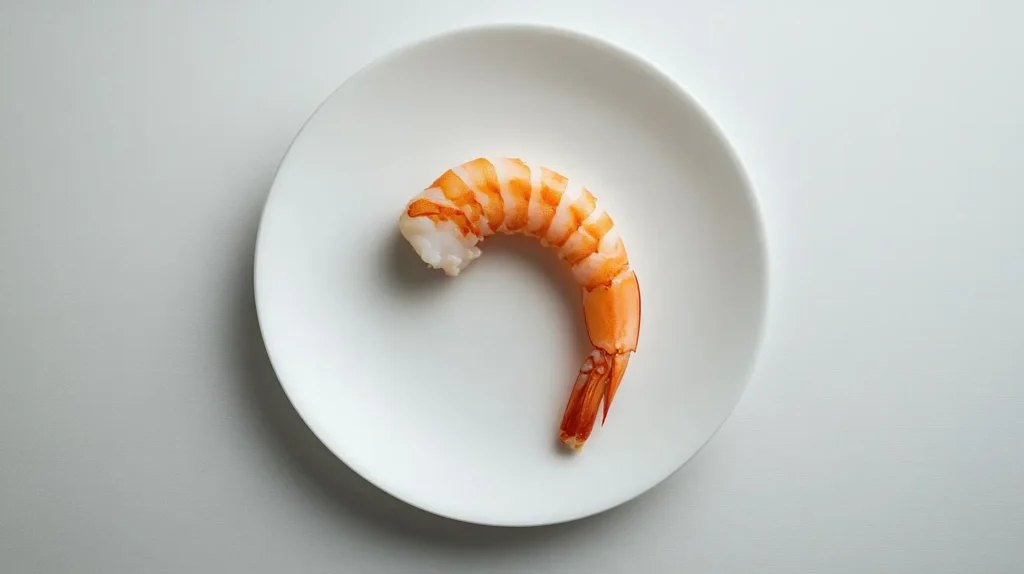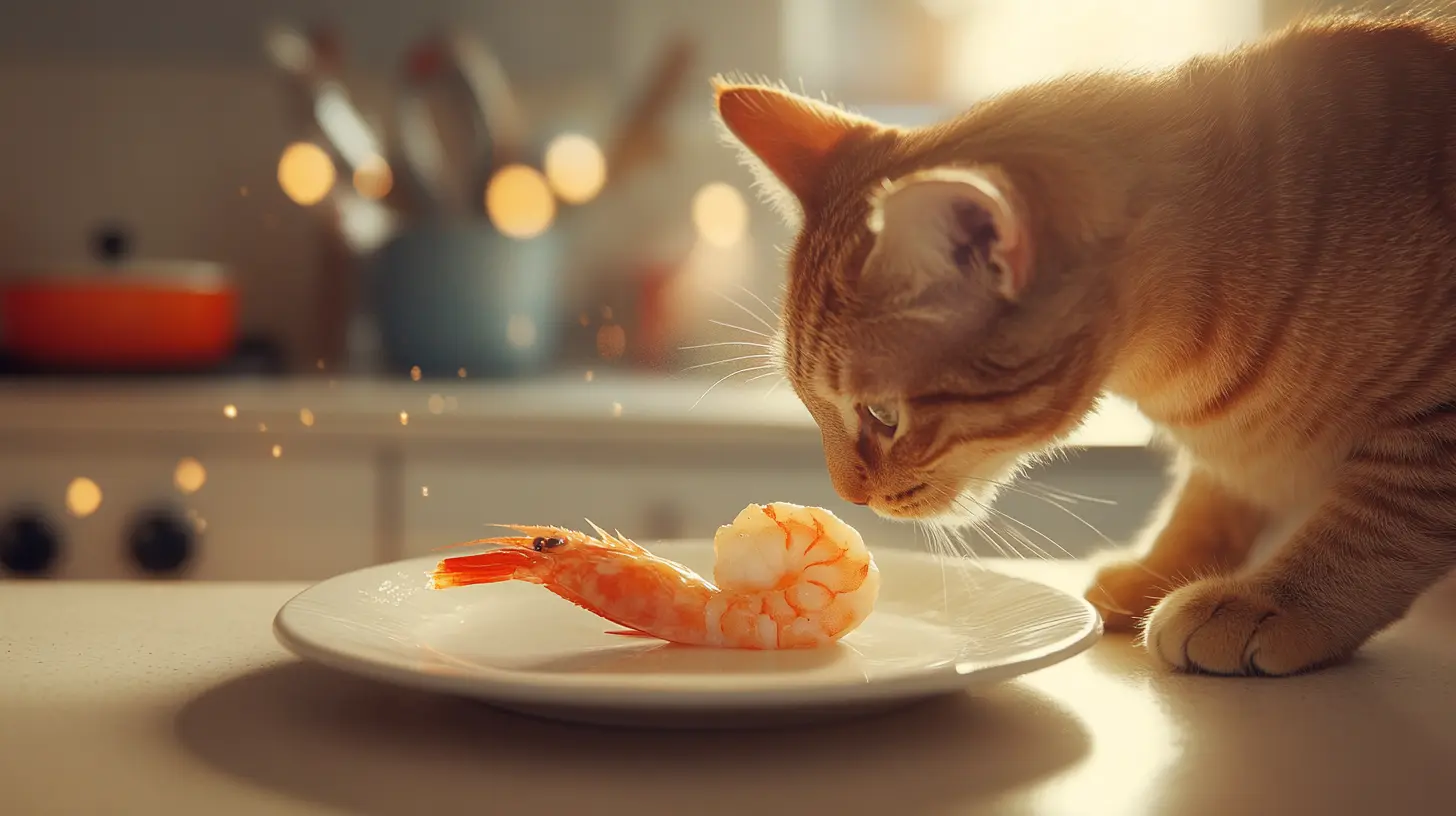Introduction
If you’re a cat owner who loves seafood, you might have wondered, “Can cats have shrimp?” Cats are naturally curious creatures, especially when it comes to food. If your feline friend has ever stared at you while you enjoy a plate of shrimp, you might feel tempted to share a bite. But is shrimp safe for cats?
In this article, we’ll explore whether shrimp is a healthy treat for your furry companion. We’ll dive into the nutritional benefits, potential risks, proper preparation methods, and other seafood options that can add variety to your cat’s diet. By the end, you’ll know exactly how to safely treat your cat to this popular seafood delicacy.
Table of contents
The Nutritional Value of Shrimp

Shrimp is a tasty and nutrient-rich seafood that’s not only popular with humans but can also offer some health benefits to cats when given in moderation. Let’s break down what makes shrimp a potentially good snack for your furry friend.
Benefits of Shrimp for Cats
Shrimp is high in protein, which is essential for cats as obligate carnivores. Protein helps with muscle maintenance, energy levels, and overall body repair. Including protein-rich treats like shrimp in a cat’s diet can complement their regular meals, adding a bit of variety to their nutrition.
Shrimp is also low in calories and fat, making it a great occasional treat for cats that are prone to weight gain. Unlike other fatty foods, shrimp won’t add unnecessary calories to their diet, as long as it’s prepared correctly.
Key Nutrients Found in Shrimp
Shrimp is packed with essential nutrients that cats can benefit from, including:
- Omega-3 Fatty Acids: These promote a shiny coat and healthy skin while supporting overall heart health.
- Taurine: A vital amino acid for cats that aids in maintaining heart function and vision.
- Vitamin B12: Supports your cat’s nervous system and helps maintain energy levels.
- Minerals like Selenium and Zinc: Selenium acts as an antioxidant, while zinc supports a healthy immune system.
How Shrimp Supports Feline Health
Including shrimp in a cat’s diet can have several advantages, such as:
- Boosting energy levels due to its high protein content.
- Improving skin and coat health because of omega-3 fatty acids.
- Supporting a strong immune system thanks to its minerals and vitamins.
However, while shrimp can be nutritious, it’s essential to balance it with your cat’s regular diet. Shrimp should never replace a complete and balanced cat food that meets all of your pet’s dietary needs.
Is Shrimp Safe for Cats to Eat?

While shrimp has nutritional benefits, it’s natural to wonder whether it’s entirely safe for your feline friend. The answer is yes—cats can enjoy shrimp as an occasional treat, but there are some important safety considerations to keep in mind.
Cooked vs. Raw Shrimp: What’s Better?
When it comes to feeding shrimp to your cat, cooked shrimp is the safest option. Cooking eliminates harmful bacteria or parasites that might be present in raw seafood. Boiling or steaming shrimp without any added seasonings is the ideal method to ensure it’s safe for your pet.
Raw shrimp, on the other hand, carries potential risks, such as contamination with harmful pathogens like Salmonella or Listeria. While some cats may be fine after eating raw shrimp, the risks often outweigh the benefits.
Potential Risks and Allergies
Even though shrimp is generally safe for cats, there are a few risks to be aware of:
- Allergic Reactions: Some cats might develop an allergy or sensitivity to shrimp. Symptoms include vomiting, diarrhea, or skin irritation.
- Choking Hazard: Shrimp shells, tails, and veins can be difficult for cats to chew or digest, posing a choking hazard.
- Seasonings and Additives: Shrimp prepared with garlic, onion, salt, or spices is toxic to cats. Always avoid giving your cat shrimp that’s been seasoned.
How Much Shrimp Can a Cat Safely Eat?
Moderation is key when it comes to feeding shrimp to your cat. Shrimp should be treated as an occasional snack, not a regular part of their diet. A small piece or two is typically sufficient for most cats.
Keep in mind:
- Too much shrimp can upset your cat’s stomach or lead to imbalances in their diet.
- Shrimp should not exceed 10% of your cat’s total daily calorie intake.
When introducing shrimp to your cat for the first time, start with a small portion and observe how they react. If they show any signs of discomfort or allergies, it’s best to avoid shrimp in the future.
How to Prepare Shrimp for Your Cat
Preparing shrimp the right way is crucial to ensure it’s both safe and enjoyable for your cat. Cats have delicate digestive systems, so following specific guidelines will help prevent any issues while keeping the treat as healthy as possible.
Dos and Don’ts of Feeding Shrimp to Cats
Here are some key points to remember when serving shrimp to your cat:
Dos:
- Choose fresh or frozen shrimp: Fresh shrimp is ideal, but frozen shrimp works just as well as long as it’s properly thawed.
- Cook the shrimp: Always boil or steam shrimp without adding any seasonings or oils.
- Remove shells, tails, and veins: These parts can be tough to digest and may pose a choking hazard.
Don’ts:
- Avoid raw shrimp: The risk of bacteria or parasites is too high.
- Say no to fried shrimp: The oil and breading are not suitable for cats and can cause stomach upset.
- Skip the seasonings: Garlic, onion, salt, and spices are toxic to cats.
Best Cooking Methods for Cat-Friendly Shrimp
Simple cooking methods like boiling or steaming are perfect for preparing shrimp for cats. Here’s how you can do it:
- Boiling: Drop fresh, de-veined shrimp into a pot of boiling water for 2–3 minutes until fully cooked.
- Steaming: Place the shrimp in a steamer for about 5 minutes or until they turn opaque.
Once cooked, allow the shrimp to cool completely. Chop it into bite-sized pieces before offering it to your cat.
Avoiding Seasonings and Additives
Cats don’t need seasoning to enjoy shrimp. Many spices and additives commonly used in human recipes, such as garlic, onion, butter, or salt, are harmful to cats. Plain shrimp is the safest choice.
Additionally:
- Avoid pre-cooked shrimp, as it often contains preservatives or flavorings unsuitable for cats.
- Check ingredient labels if purchasing frozen shrimp to ensure there are no added chemicals.
Proper preparation ensures that shrimp remains a nutritious and safe treat for your feline friend, free from any harmful substances.
Signs of Shrimp Allergy or Sensitivity in Cats
Even though shrimp is safe for most cats, some felines may develop allergies or sensitivities to it. It’s essential to monitor your cat closely after introducing shrimp into their diet, especially if it’s their first time trying it.
Common Symptoms of Food Allergies in Cats
If your cat is allergic or sensitive to shrimp, they may exhibit one or more of the following symptoms:
- Digestive Issues: Vomiting, diarrhea, or excessive gas can indicate that your cat’s stomach isn’t tolerating shrimp well.
- Skin Irritation: Look for redness, itching, or excessive grooming, especially around their face, paws, or ears.
- Respiratory Problems: In rare cases, allergies may cause sneezing, coughing, or difficulty breathing.
- Lethargy: If your cat seems unusually tired or sluggish after eating shrimp, it could be a sign of an adverse reaction.
What to Do If Your Cat Reacts to Shrimp
If your cat shows any of the above symptoms, here’s how to handle the situation:
- Stop Feeding Shrimp: Discontinue giving shrimp immediately and monitor your cat’s behavior.
- Consult a Veterinarian: If the symptoms persist or worsen, seek professional advice from your vet. They may recommend allergy testing or specific treatments to ease your cat’s discomfort.
- Keep a Food Diary: Record what your cat eats, along with any symptoms, to help identify potential triggers.
Preventing Allergic Reactions in the Future
To minimize the risk of allergic reactions, follow these steps:
- Introduce shrimp gradually into your cat’s diet, starting with a very small amount.
- Avoid giving shrimp to cats with known food allergies or sensitive stomachs.
- Always prepare shrimp properly, as undercooked or contaminated shrimp can exacerbate reactions.
Being attentive to your cat’s health and dietary responses ensures that shrimp remains a safe and enjoyable treat for them.
Heading 2: Alternative Seafood Options for Cats
If your cat enjoys shrimp, you might wonder about other seafood options that could be safe and nutritious for them. While shrimp is a popular choice, there are other types of seafood that can offer variety while keeping your feline friend happy and healthy.
Cat-Friendly Fish and Seafood Choices
Cats often have a natural affinity for seafood, thanks to its strong aroma and flavor. Here are some seafood options that are generally safe for cats when prepared correctly:
- Salmon: Rich in omega-3 fatty acids, salmon supports a healthy coat and skin. Be sure to cook it thoroughly and avoid added seasonings.
- Tuna: A favorite among cats, tuna can be given occasionally. Opt for fresh or canned tuna in water (not oil) and serve in moderation to avoid mercury buildup.
- Cod: This lean fish is easy to digest and low in fat, making it an excellent option for cats with sensitive stomachs.
- Sardines: Packed with omega-3s and essential nutrients, sardines can be a tasty treat when served plain and boneless.
- Whitefish: Another mild and low-fat option, whitefish is suitable for cats that prefer a lighter seafood flavor.
Always cook seafood thoroughly to eliminate bacteria or parasites, and remove bones, shells, or skin before serving it to your cat.
Moderation is Key for Seafood Treats
While seafood can be a healthy addition to your cat’s diet, it’s essential to feed it in moderation. Too much seafood, including shrimp, can lead to nutritional imbalances or mercury exposure. Cats require a well-rounded diet primarily consisting of high-quality cat food that meets their nutritional needs.
Consider these tips for offering seafood treats:
- Limit seafood treats to once or twice a week.
- Avoid relying on seafood as a primary protein source.
- Monitor your cat’s reaction to new seafood items and consult a vet if you notice any adverse effects.
Benefits of Variety in Treats
Offering different types of seafood as treats can provide your cat with a range of nutrients and prevent them from becoming too reliant on a single food source. Rotating between shrimp, salmon, and other options ensures that your cat enjoys a diverse and balanced diet.
By exploring alternative seafood options, you can keep your cat’s treat time exciting while ensuring they receive the nutritional benefits they need.
FAQs
When it comes to feeding shrimp to cats, pet owners often have plenty of questions. Here are answers to some of the most common concerns about shrimp and other seafood treats for cats.
Can Kittens Eat Shrimp?
Yes, kittens can eat shrimp, but only after they’ve transitioned to solid food and their digestive systems have matured. Start with a very small, cooked piece to ensure it doesn’t upset their stomach. Avoid giving shrimp to very young kittens who are still reliant on a specialized kitten diet for growth and development.
Are Shrimp Shells or Tails Safe for Cats?
No, shrimp shells and tails are not safe for cats. These parts are hard to chew and digest, posing a choking hazard or risk of gastrointestinal blockage. Always remove the shell, tail, and vein before serving shrimp to your cat.
Can Cats Eat Shrimp Every Day?
Cats should not eat shrimp every day. While shrimp can be a nutritious treat, feeding it too frequently may lead to an unbalanced diet or health issues. Treat shrimp as an occasional snack and stick to a balanced cat food for their main meals.
What Other Human Foods Are Safe for Cats?
In addition to shrimp, some other human foods are safe for cats in moderation, such as:
- Cooked chicken or turkey (plain, no seasoning)
- Small pieces of cooked fish like salmon or cod
- A bite of plain scrambled egg Always avoid foods toxic to cats, including chocolate, onions, garlic, and anything seasoned.
Are Shrimp-Based Cat Treats Safe?
Commercial shrimp-based cat treats are generally safe, as they are specially formulated for feline consumption. However, it’s always a good idea to check the ingredient list for any additives or preservatives that might not suit your cat.
Should Cats with Sensitive Stomachs Eat Shrimp?
Cats with sensitive stomachs may struggle to digest shrimp. If your cat has a history of digestive issues, consult your veterinarian before introducing shrimp into their diet. Always start with a very small portion and observe their reaction.
Conclusion
Shrimp can be a tasty and nutritious treat for your cat when prepared correctly. Always serve shrimp plain, cooked, and free of shells or tails to ensure safety. While shrimp offers benefits like protein and omega-3 fatty acids, it should only be given as an occasional treat and not as a regular part of your cat’s diet. Remember to monitor your cat for any adverse reactions and consult your veterinarian if you have concerns.
For more on shrimp preparation and safety, check out these related articles:
- Discover the perfect way to grill shrimp with this BBQ Shrimp Recipe.
- Learn whether to use butter or oil when cooking shrimp in Is It Best to Cook Shrimp in Butter or Oil.
- Get tips on the ideal cooking time for shrimp on the grill in How Long Do Shrimp Take on the Barbecue.
With the right precautions, shrimp can be a delightful treat for your furry friend!

